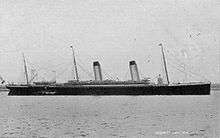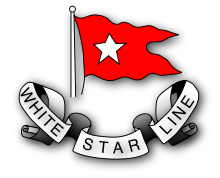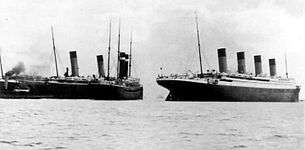RMS Oceanic (1899)
 | |
| History | |
|---|---|
| Name: |
|
| Owner: | White Star Line |
| Operator: |
|
| Route: | Liverpool/Southampton to New York |
| Builder: | Harland and Wolff, Belfast |
| Yard number: | 317 |
| Laid down: | 1897 |
| Launched: | 14 January 1899 |
| Completed: | 26 August 1899 |
| Maiden voyage: | 6 September 1899 |
| Fate: | Ran aground off, Foula, Shetland, 8 September 1914 |
| Status: |
|
| General characteristics | |
| Tonnage: | 17,272 gross tonnes |
| Length: | 704 ft (215 m) |
| Beam: | 68.4 ft (20.8 m) |
| Installed power: | Triple expansion reciprocating engines; 28,000 horsepower. |
| Propulsion: | Twin propeller |
| Speed: | 19 knots max 21 kn |
| Capacity: |
|
| Crew: | 349 |
| Notes: | Funnels: 2 Masts: 3 |
RMS Oceanic was a transatlantic ocean liner built for the White Star Line. She sailed on her maiden voyage on 6 September 1899 and was the largest ship in the world until 1901.[1] At the outbreak of World War I she was converted to an armed merchant cruiser. On 8 August 1914 she was commissioned into Royal Navy service.
On 25 August 1914, the newly designated HMS Oceanic departed Southampton to patrol the waters from the North Scottish mainland to the Faroes. On 8 September she ran aground and was wrecked off the island of Foula, near the Shetland Islands.
Construction
Oceanic's keel was laid in January 1897 under the supervision of her designer, Thomas Ismay, director and owner of the Oceanic Steam Navigation Company, better known as White Star Line. The company's future flagship was named after the line's original namesake, their first successful liner the RMS Oceanic.[2]
A sister ship for Oceanic to be named Olympic was planned. However she was cancelled after the death of Thomas Ismay in 1899, and the company's resources were diverted to develop a new set of larger liners, known as the "Big Four". The name Olympic was later bestowed upon the RMS Olympic of 1910.
Oceanic was the first ship to exceed Brunel's SS Great Eastern in length, although not in tonnage, and was, when she was launched, the largest ship afloat, a title she retained until 1901 when White Star Line's RMS Celtic was launched.[2]

At 17,272 gross tons, the future "Queen of the Ocean" cost one million pounds sterling and required 1,500 shipwrights to complete. Her launching on 14 January 1899 was watched by over 1,000 invited guests, including the Marquis of Dufferin, Duke of Abercorn and Lord Londonderry. RMS Oceanic's bridge was integrated with her superstructure giving her a clean fluid look, this design feature would later be omitted from the next big four White Star ships, Cedric, Celtic, Baltic and Adriatic with their odd but distinguishable 'island' bridges. "Nothing but the very finest", was Ismay’s policy toward this new venture, and she was constructed at Harland and Wolff’s Queen's Island yard at Belfast, as was the tradition with White Star Line ships.[3]
Oceanic was built to accommodate slightly over 1,700 passengers, with 349 crew. In his autobiography, Titanic and Other Ships,[4] Charles Lightoller gives an account of what it was like to be an officer on this vessel.
Career
In 1900, in heavy fog (which lasted for four days), Oceanic was rescued by being put on the right course by a local skipper, Captain Peter Harrison on his flat boat the Alice Linda. Oceanic had almost run aground off the seaside town of Cleveleys on the Fylde coast in Lancashire. After that incident, the Oceanic always had a special greeting for Captain Harrison's boat whenever the two met at Liverpool. One of Peter Harrison's valued possessions was a pair of binoculars presented to him by the White Star officials in recognition of his timely action.[5]
In 1901, in a heavy fog, Oceanic was involved in a collision when she rammed and sank the small Waterford Steamship Company SS Kincora, killing seven.[3]
In 1905, Oceanic was the first White Star Line ship to suffer a mutiny, which resulted in the conviction and imprisonment of 35 stokers upset with the officers over working conditions.[6]
In April 1912, during the departure of RMS Titanic from Southampton, Oceanic became involved in the near collision of Titanic with SS New York, when Oceanic was nearby as New York broke from her mooring and nearly collided with Titanic, due to the large wake caused by Titanic′s size and speed.
A month later, in mid-May 1912, Oceanic picked up three bodies in one of the lifeboats left floating in the North Atlantic after Titanic sank.[lower-alpha 1] After their retrieval from Collapsible A by Oceanic, the bodies were buried at sea.[7]
World War I
Shortly after the outbreak of the First World War in 1914, Oceanic was included in a deal with the Admiralty, which made an annual grant toward the maintenance of any ship on the condition that it could be called upon for naval work, during times of war. Such ships were built to particular naval specifications, in the case of Oceanic so that the 4.7 inch guns she was to be given could be quickly mounted. "The greatest liner of her day" was commissioned into Naval service on 8 August 1914 as an armed merchant cruiser.
On 25 August 1914, the newly designated HMS Oceanic departed Southampton on naval service that was to last just two weeks. Oceanic was to patrol the waters from the North Scottish mainland to the Faroes, in particular the area around Shetland. She was empowered to stop shipping at her Captain’s discretion, and to check cargoes and personnel for any potential German connections. For these duties, she carried Royal Marines and Captain William Slayter RN was appointed in command. Her former Merchant Master, Captain Henry Smith, with two years' service, remained in the ship with the rank of Commander RNR. Many of the original crew also continued to serve on Oceanic.
Disaster

Oceanic headed for Scapa Flow in Orkney, Britain’s main naval anchorage, with easy access to the North Sea and the Atlantic. From here she proceeded north to Shetland travelling continuously on a standard zigzag course as a precaution against being targeted by U-boats. This difficult manoeuvring required extremely accurate navigation, especially with such a large vessel. In the event it appears to have been poor navigation, rather than enemy action that was to doom Oceanic.
An inaccurate fix of their position was made on the night of 7 September by navigator Lieutenant David Blair RNR (previously assigned to, then reassigned from, the Titanic). While everyone on the bridge thought they were well to the southwest of the Isle of Foula, they were in fact an estimated thirteen to fourteen miles off course and on the wrong side of the island. This put them directly on course for a reef, the notorious Shaalds of Foula, which poses a major threat to shipping, coming within a few feet of the surface, and in calm weather giving no warning sign whatsoever.
Captain Slayter had retired after his night watch, unaware of the situation, with orders to steer to Foula. Commander Smith took over the morning watch, and with his former knowledge of the ship was only happy when the ship was in open sea. Having previously disagreed with his naval superior about dodging around the island, he instructed the navigator to plot a course out to sea. Slayter must have felt the course change, as he reappeared on the bridge to countermand Smith's order and made what turned out to be a hasty and ill-informed judgement which resulted in the ship running directly onto the Shaalds on the morning of 8 September. She was wrecked in a flat calm and clear weather. She was the first Allied passenger ship to be lost in the war.
Rescue
The Aberdeen trawler, Glenogil, was the first vessel on the scene, and although she attempted to pull off the massive ship, it proved an impossible task, and with the hull already ruptured, Oceanic would not have stayed afloat long in open waters.[8] Other ships in the area were called in to assist in the rescue operation that was to follow. All of the ship's crew transferred to the trawler via the ship's lifeboats and were then ferried to the waiting AMC HMS Alsatian, and HMS Forward. Charles Lightoller, the ship's First Officer (and also the most senior officer to survive the sinking of the Titanic), was the last man off, taking the navigation room's clock as a souvenir.
The 573-ton Admiralty salvage vessel Lyons was dispatched to the scene hurriedly, and in the words of the Laird of Foula, Professor Ian S. Holbourn, writing about the disaster in his book The Isle of Foula:
The launch of the Lyons, a salvage boat which hurried to the scene, was capable of a speed of ten knots, yet was unable to make any headway against the tide although she tried for fifteen minutes. Even then it was not the top of the tide, and the officer in charge reckoned the full tide would be 12 knots, he confessed he would not have believed it had he been told.[9]
Commander Smith is said to have come ashore at the remote island’s tiny pier, and on looking back out to sea toward his stranded ship two miles away, commented that the ship would stay on the reef as a monument and nothing would move it. One of the Foula men, wise to the full power and fury of a Shetland storm, is said to have muttered with a cynicism not unknown in those parts "I‘ll give her two weeks".[9]
Remarkably, following a heavy gale that had persisted throughout the night of 29 September, just two weeks after the incident the islanders discovered the following day that the ship had been entirely swallowed up by the sea, where she remains to this day scattered as she fell apart under the pressure of the seas on the Shaalds.
The disaster was hushed up at the time, since it was felt that it would have been embarrassing to make public how a world-famous liner had run aground in friendly waters in good weather within a fortnight of beginning its service as a naval vessel. The revelation of such gross incompetence at this early stage of the war would have done nothing for national morale.
Courts-martial
Lt. Blair was court-martialled at Devonport in November 1914, when he was found guilty of "stranding or suffering to be stranded" HMS Oceanic, and was ordered to be reprimanded. He offered in his defence that he was exonerated by the evidence given by Captain Slayter and Commander Smith that he was under their supervision, and that the stranding was due to abnormal currents.
A similar charge was made against Commander Smith at a second court-martial; the evidence for the prosecution was the same as in the previous case, but witnesses were cross-examined with a view to showing that the position of the accused on Oceanic was not clearly defined by the naval authorities, and that he was understood to be acting solely in an advisory capacity. He was acquitted the following day, as he was found not to have been in command on 8 September.
Captain Slayter was also acquitted.
Salvage
In 1924, a salvage company which had been engaged on the scuttled German warships at Scapa Flow cut what remained of the wreck of Oceanic down to water level and salvaged. In 1973 work began to remove more of the wreck and in 1979, the last remains of the strong hull were completely removed after 65 years.[10]
Notes
- ↑ Thomas Beattie, a first class passenger, and two crew members, a fireman and a seaman.
References
- ↑ "R.M.S. Oceanic (II)". Jeff Newman. Retrieved 2010-01-18.
- 1 2 Oceanic II - thegreatoceanliners.com
- 1 2 "RMS Oceanic". Darrel R. Hagberg. Retrieved 2008-12-12.
- ↑ Lightoller, C.H. (1935). Titanic and other ships. I. Nicholson and Watson. Retrieved 2008-12-13. republished as a Gutenberg of Australia eBook
- ↑ Captains Harrisons Family Tree data
- ↑ "Mutiny Aboard A White Star Line Ship". Titanic and Other White Star Line Ships. Retrieved 2008-12-13.
- ↑ Bartlett 2011, pp. 242–243.
- ↑ "Oceanic". The Great Ocean Liners. Retrieved 2008-03-28. External link in
|publisher=(help) - 1 2 Holbourn, Ian Stoughton (2001). The Isle of Foula. Birlinn Ltd. ISBN 1-84158-161-5.
- ↑ Navy News. United Kingdom Ministry of Defence (628). November 2006. Missing or empty
|title=(help); External link in|journal=(help)
Further reading
- The Other Titanic, Simon Martin (Salvage report, 1980)..
External links
| Wikimedia Commons has media related to RMS Oceanic. |
- Oceanic on thegreatoceanliners.com
- "Oceanic". Great Ships. Retrieved 2008-12-13.
- Oceanic - at the White Star Line History Website.
- White Star Line Brochure 1907 contains photographs and accommodation descriptions for Oceanic and other White Star ships.
- YouTube video dedicated to the RMS Oceanic

